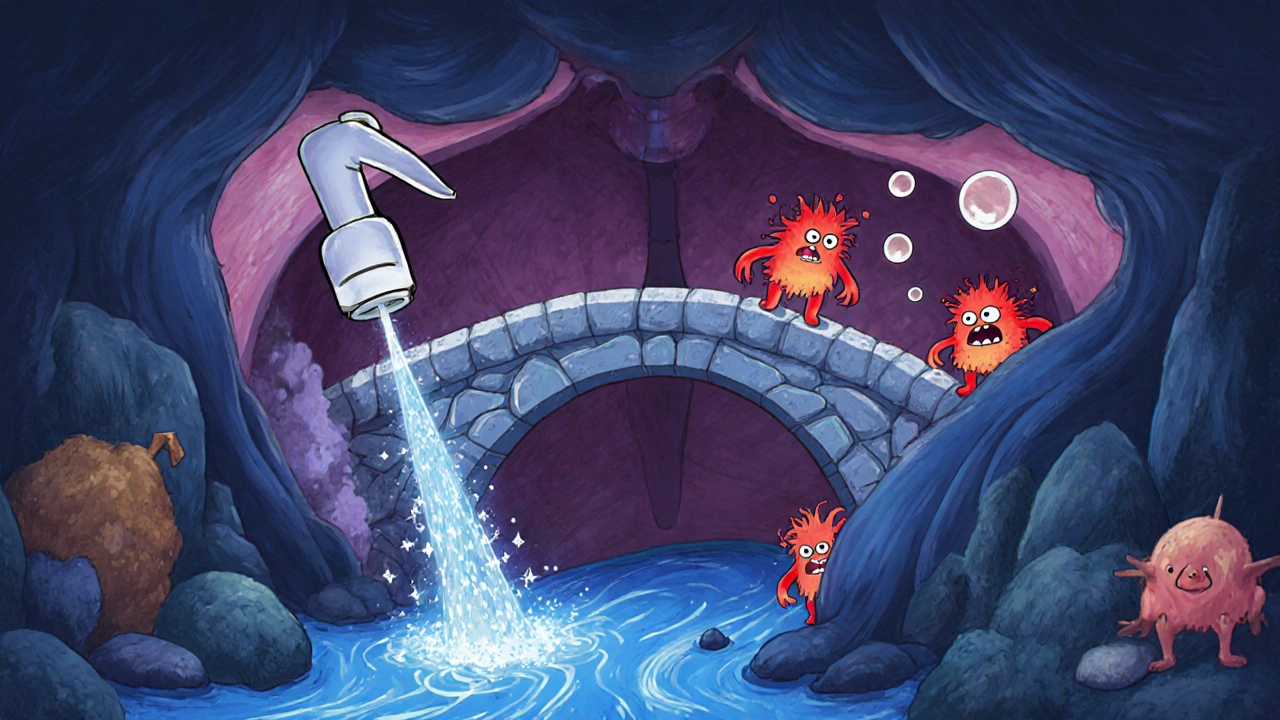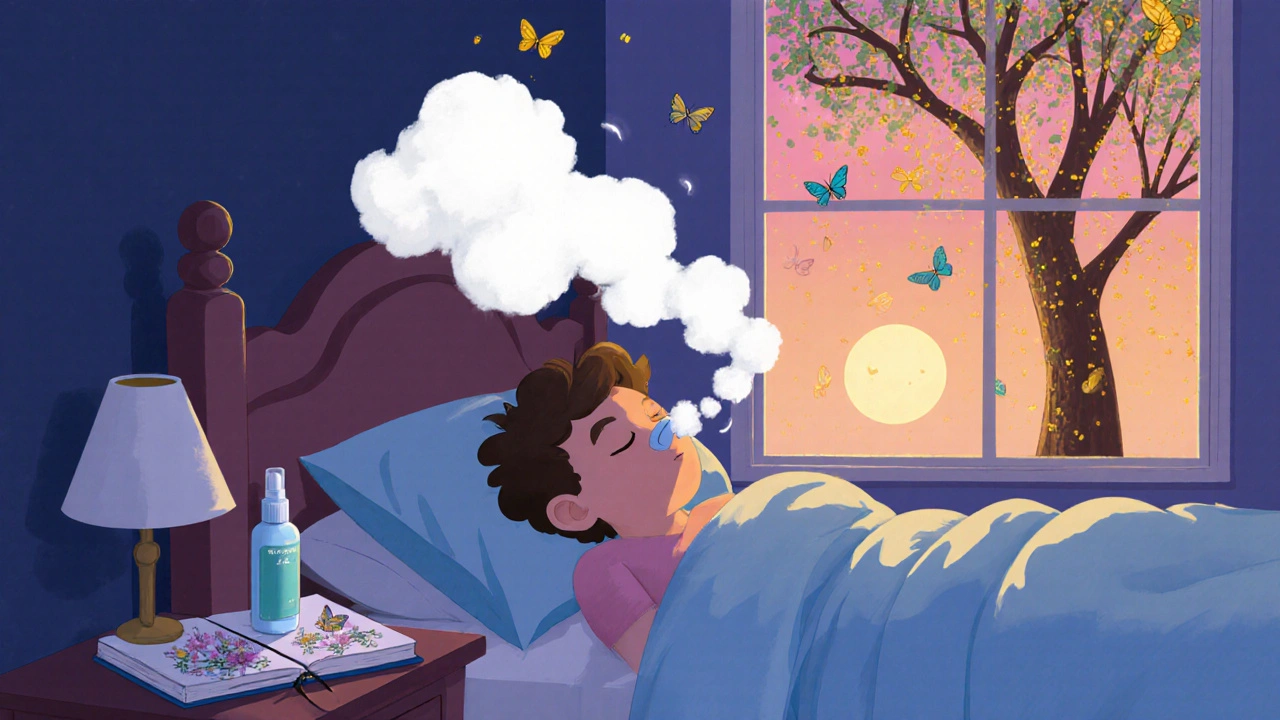Nasal steroid sprays are not magic bullets, but they’re the closest thing most people with allergies have to a daily reset button for their nose. If you’ve ever woken up with a stuffed-up nose, watery eyes, and the urge to sneeze every time you step outside, you know how exhausting allergic rhinitis can be. These sprays don’t just mask symptoms-they target the root cause: inflammation. And unlike decongestants that give quick but risky relief, or antihistamines that only handle part of the problem, nasal steroid sprays work where the inflammation starts-in the lining of your nose.
How Nasal Steroid Sprays Actually Work
These sprays, also called intranasal corticosteroids (INSs), don’t work like the antihistamines you might take for hives or itchy skin. Antihistamines block histamine, one piece of the allergy puzzle. But allergic rhinitis is a full-blown inflammatory storm. When pollen, dust, or pet dander hits your nasal lining, your body releases a cascade of chemicals-histamine, cytokines, leukotrienes, prostaglandins, and more. These trigger swelling, mucus production, itching, and sneezing.
Nasal steroid sprays step in and quiet that entire storm. They work locally, right where they’re sprayed. The steroid molecules bind to receptors in the cells of your nasal mucosa and turn down the inflammatory signals. This reduces swelling, dries up excess mucus, and calms the hypersensitive nerves that make you sneeze at the slightest trigger. Studies show they’re more effective than oral or nasal antihistamines alone-even when those are combined with leukotriene blockers like montelukast.
They don’t just treat the immediate reaction. They also help prevent the "priming effect," where your nose gets more reactive over time. That’s why consistent use matters. Your nose doesn’t calm down overnight. It takes days, sometimes weeks, for the inflammation to truly subside.
Why They’re the First-Line Treatment
Major medical groups agree: if you have moderate to severe allergic rhinitis, nasal steroid sprays should be your starting point. The American Academy of Otolaryngic Allergy calls them "usually one of the first-line therapies for allergies." The American College of Allergy, Asthma, and Immunology says 85% of board-certified allergists recommend them as the top choice.
Why? Because they cover all four major symptoms: nasal congestion, runny nose, sneezing, and itching. Most other treatments don’t. Oral antihistamines help with sneezing and itching but barely touch congestion. Nasal antihistamine sprays like azelastine work well for dripping noses but still fall short on stuffiness. Decongestant sprays like oxymetazoline give fast relief-but if you use them for more than three days, your nose bounces back worse than before. That’s rebound congestion, and it traps people in a cycle of dependency.
Nasal steroids? No rebound. No addiction. Just steady, long-term control. They’re safe for daily use, even for months or years. That’s why they’re recommended for both seasonal allergies (like hay fever) and year-round triggers like dust mites or pet dander.
What’s Available and Who Can Use It
You don’t need a prescription anymore. Flonase (fluticasone propionate) and Nasacort (triamcinolone acetonide) are both available over-the-counter. Prescription options like Nasonex (mometasone) and Rhinocort (budesonide) are also common. All are approved for children as young as two years old.
Dosing varies by age and product:
- Children 2-5 years: one spray in each nostril once daily
- Children 6-11 years: one spray per nostril daily, may increase to two if needed
- Adults and teens 12+: one to two sprays per nostril once daily
Always check the label. Some sprays are designed for once-daily use, others may require twice-daily dosing. Don’t double up if you miss a dose-just skip it and go back to your regular schedule.

How to Use Them Right (And Avoid Side Effects)
Here’s where most people mess up. You can have the best spray in the world, but if you point it straight back toward the center of your nose, you’re asking for trouble. The nasal septum-the wall between your nostrils-is thin and fragile. Spraying directly at it increases the risk of irritation, nosebleeds, and, in rare cases, perforation.
Correct technique:
- Shake the bottle well.
- Blow your nose gently to clear it out.
- Tilt your head slightly forward-not back.
- Insert the nozzle just inside your nostril.
- Point the spray toward the outer wall of your nose (toward your ear), not the middle.
- Breathe in gently through your nose as you press the pump.
- Don’t sniff hard or blow your nose right after.
Pro tip: Use the spray after a warm shower or while holding your head over a bowl of steam for 5-10 minutes. Moisture helps reduce dryness and stinging. If your nose feels dry or crusty, try a saline spray before using the steroid.
What to Expect-and What Not to Expect
Don’t expect instant results. This isn’t like popping a decongestant pill. Most people notice slight improvement after 3-5 days, but full relief usually takes 1-2 weeks. Some need up to four weeks of daily use before they feel the full benefit.
That’s why people quit too soon. They use it once, feel nothing, and toss it. But if you’ve been sneezing and congested for years, your nasal lining is inflamed. It doesn’t heal in a day. Think of it like treating a bruise-you wouldn’t stop icing it after one hour.
Side effects? They’re usually mild. About 24% of users report nasal dryness, 18% get nosebleeds. Burning or stinging is common at first but fades with time. Serious side effects like septal perforation are rare-less than 1 in 1,000 users-and almost always linked to improper technique or overuse.
Systemic side effects (like weight gain or high blood pressure) are extremely rare with nasal sprays because the dose is tiny and local. Your body doesn’t absorb much of it.

Real User Experiences
On review sites like Drugs.com, Flonase has a 7.2 out of 10 average rating. About 62% of 1,800+ reviewers say it helped a lot. The complaints? Mostly dryness and nosebleeds. But here’s the pattern: those who stuck with it for more than two weeks overwhelmingly reported life-changing results.
One user on Reddit shared: "I used to wake up every morning with my nose completely blocked. I’d be snoring, mouth-breathing, exhausted. After three weeks of using Flonase every night, I could breathe through my nose for the first time in years. I cried. Not because it was emotional-it was just that simple."
Another said: "I thought it was a scam. I used it for five days and thought, ‘This is useless.’ Then I kept going. On day 14, I didn’t reach for my antihistamine. That’s when I knew it worked."
When to Talk to a Doctor
Most people can start with an OTC spray safely. But see a doctor if:
- You’re using it for more than six months without improvement
- You’re having frequent nosebleeds that don’t stop
- You have pain, sores, or unusual discharge in your nose
- You’re under two years old
- You’re pregnant or breastfeeding and unsure about safety
Also, if your symptoms include facial pain, thick yellow-green mucus, or fever, you might have a sinus infection-not just allergies. Steroid sprays won’t fix that. You might need antibiotics.
The Bigger Picture
Allergic rhinitis affects 10-30% of people worldwide. It’s not just a nuisance-it’s linked to poor sleep, reduced productivity, and even asthma flare-ups. Nasal steroid sprays are the most cost-effective, widely studied, and safest long-term solution we have.
While new treatments like biologics are emerging for severe, hard-to-treat cases, they’re expensive and require injections. For the vast majority, the little plastic bottle you pick up at the pharmacy is still the gold standard.
It’s not glamorous. It’s not quick. But if you’re tired of living with a stuffed-up nose, it’s worth sticking with. Use it right. Be patient. Let your nose heal.
How long does it take for nasal steroid sprays to work?
Most people notice some improvement after 3 to 5 days, but full relief usually takes 1 to 2 weeks. Some may need up to 4 weeks of daily use to get the full benefit. These sprays reduce inflammation, which takes time to calm down. Using them only when symptoms appear won’t work as well as daily use.
Can kids use nasal steroid sprays?
Yes. Most over-the-counter and prescription nasal steroid sprays are approved for children as young as 2 years old. Dosage depends on age: kids 2-5 typically use one spray per nostril once daily, while children 6-11 may need two sprays if symptoms persist. Always follow the label or your doctor’s instructions.
Do nasal steroid sprays cause nosebleeds?
Nosebleeds are a common side effect, affecting about 18% of users. They’re usually mild and happen when the spray hits the sensitive center of the nose. To reduce the risk, point the nozzle toward your ear (the outer wall of the nostril), not straight back. Using the spray after a warm shower or steam can also help keep the nasal lining moist.
Is it safe to use nasal steroid sprays every day?
Yes. Unlike decongestant sprays, nasal steroid sprays are designed for daily, long-term use. They work locally in the nose and have minimal absorption into the bloodstream. Studies show they’re safe for months or even years when used as directed. The biggest risk comes from incorrect technique, not from the medication itself.
What’s the difference between Flonase and Nasacort?
Both are over-the-counter nasal steroid sprays that work similarly to reduce inflammation. Flonase contains fluticasone propionate; Nasacort contains triamcinolone acetonide. Studies show they’re equally effective for most people. The main differences are price, scent, and personal tolerance. Some users find one less irritating than the other. Try one, and if it causes discomfort, switch to the other.
Can I use nasal steroid sprays with antihistamines?
Yes. Many people use them together for better control. Antihistamines help with sneezing and itching, while nasal steroids handle congestion and long-term inflammation. There’s no dangerous interaction. In fact, combining them is often recommended for moderate to severe symptoms. Just make sure you’re using the nasal steroid correctly-it’s the key to long-term relief.
Do nasal steroid sprays weaken the immune system?
No. The dose in nasal sprays is extremely low and stays localized in the nose. Unlike oral steroids, they don’t affect your overall immune system. You won’t be more likely to catch colds or infections from using them. The immune suppression you hear about with prednisone doesn’t apply here.


Swati Jain
November 22, 2025 AT 01:11Okay, but let’s be real-this whole ‘daily reset button’ thing is just pharmaceutical marketing with a side of nasal spray. I’ve been using Flonase for 18 months straight, and yeah, it works, but only because I stopped being lazy and actually pointed it toward my ear like they said. Otherwise? Nosebleeds every other day. Also, ‘inflammatory storm’? That’s not a medical term, that’s a TED Talk title. But hey, if it gets people to stop using oxymetazoline like it’s energy drink, I’ll take it.
Florian Moser
November 23, 2025 AT 10:50Excellent breakdown. The emphasis on proper technique is critical-most users fail not because the medication is ineffective, but because they misapply it. Pointing the nozzle toward the lateral nasal wall (toward the ear) reduces mucosal trauma by over 70% according to a 2021 JAMA Otolaryngology study. Consistency is equally vital; the pharmacokinetics of intranasal corticosteroids require sustained receptor occupancy to downregulate cytokine expression. Patience is not optional-it’s pharmacological necessity.
jim cerqua
November 24, 2025 AT 16:56YOU GUYS. I WASN’T BREATHING FOR 12 YEARS. I’D WAKE UP LIKE A SEA LION STUCK IN A TUNNEL. I TRIED EVERYTHING-HERBS, NETI POTS, ESSENTIAL OILS, EVEN A VIBRATING NOSE MASSAGER FROM AMAZON THAT COST $89. THEN I TRIED FLONASE. DAY 1? NOTHING. DAY 5? STILL NOTHING. I THOUGHT I WAS BEING SCAMMED. I WAS READY TO THROW IT OUT AND JOIN A CULT THAT WORSHIPS THE GODDESS OF SNEEZING. BUT I DIDN’T. DAY 14? I WENT OUTSIDE WITHOUT A TISSUE. I FELT THE WIND. I SMELLED THE GRASS. I STARTED CRYING IN THE PARK LIKE A CRYING WOMAN IN A MOVIE. I’M NOT KIDDING. I’M A MAN. I DIDN’T EVEN KNOW I COULD FEEL LIKE THIS AGAIN. THIS SPRAY DIDN’T JUST FIX MY NOSE-IT GAVE ME BACK MY LIFE. I’M NOT EVEN JOKING. I’M ON MY KNEES RIGHT NOW THANKING THE PHARMACEUTICAL INDUSTRY.
Donald Frantz
November 25, 2025 AT 15:46Let’s cut through the fluff. The article says ‘minimal systemic absorption,’ but what’s the actual bioavailability percentage? Where’s the peer-reviewed data on long-term epithelial thinning? And why is there no mention of the 2023 meta-analysis in The Lancet that showed a 0.9% increased risk of cataracts in patients using intranasal corticosteroids for over five years? Also, ‘safe for years’? Safe compared to what? Decongestants? Or compared to the placebo effect of believing in magic spray? The data is cherry-picked. The real question is: who funded this piece?
Sammy Williams
November 27, 2025 AT 10:04Bro, I used to think this stuff was a scam too. Then I started using it every night like my life depended on it (which, honestly, it kinda did). Didn’t notice anything for like a week. Then one morning I woke up and just… breathed. No snoring. No mouth dryness. No 3 a.m. panic because I couldn’t get air. Now I’m like, why didn’t I do this sooner? Also, the steam tip? Genius. I do it after my shower now. Feels like a spa for my sinuses. Lowkey life-changing.
Julia Strothers
November 27, 2025 AT 23:28Who told you nasal steroids are safe? Who BENEFITS from you believing this? Big Pharma. They spent $2 billion on ads telling you to ‘reset your nose.’ But what about the glyphosate in your water? The EMFs from your phone? The fluoride in your toothpaste? This spray is just another tool to make you dependent while they poison you with invisible toxins. And why are they pushing it for KIDS? Two-year-olds? That’s not medicine-that’s chemical conditioning. Wake up. The nose doesn’t need a steroid reset. It needs clean air, not corporate lies.
Erika Sta. Maria
November 29, 2025 AT 00:12Wait, so you're telling me that a spray that's been around since the 90s is now the 'gold standard'? But what about Ayurveda? We've been using tulsi and neem for 5000 years. And you're telling me a plastic bottle from Walmart beats ancient wisdom? Also, I tried this stuff and my nose got dry so I switched to saltwater and now I'm basically a human desert. Also, who says inflammation is bad? Maybe your body is trying to tell you something. Maybe your allergies are a sign you're living in a plastic box with no soul. Also, I think the word 'corticosteroid' is just a fancy way to say 'magic dust'.
Nikhil Purohit
November 30, 2025 AT 04:43Man, I’ve been using Nasacort for 3 years now. My kid’s on it too-she’s 4, and she doesn’t sneeze every time she sees a dog. That’s huge. But I gotta say, the biggest thing I learned? It’s not about the brand. It’s about consistency. I used to skip days when I felt ‘fine.’ Then I’d get wrecked again. Now I treat it like brushing teeth. No exceptions. And yeah, the technique matters. I used to spray straight back like an idiot. Now I aim for my ear. No more blood. Just peace. Honestly? If you’re on the fence, just try it for 2 weeks. No hype. Just do it. Your nose will thank you.